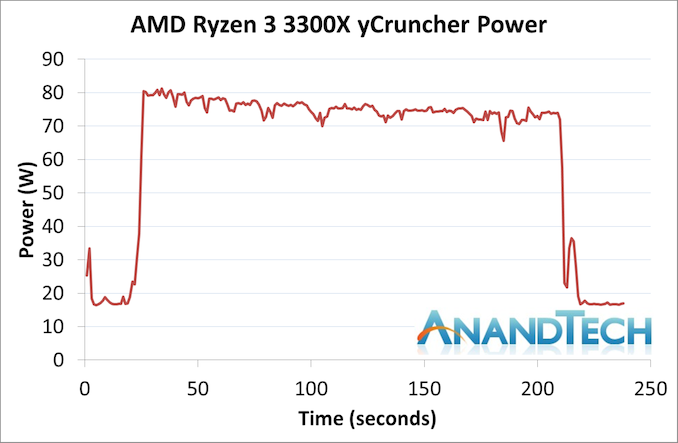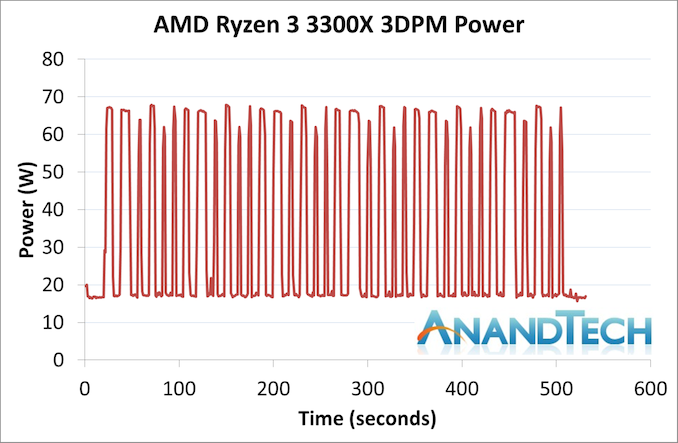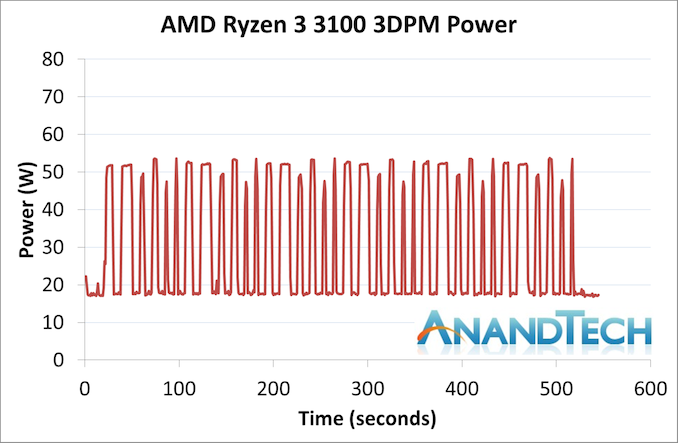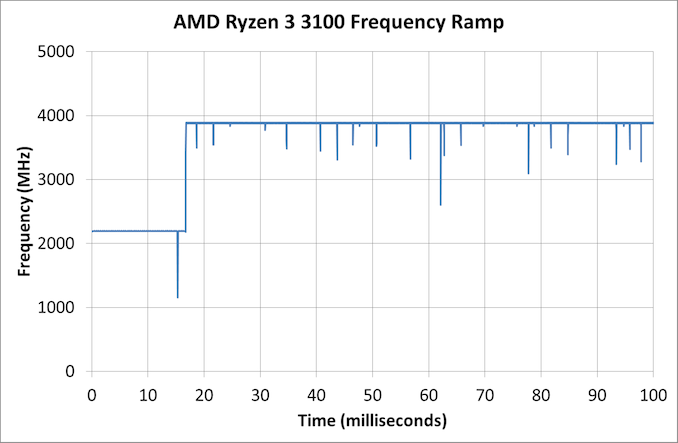The AMD Ryzen 3 3300X and 3100 CPU Review: A Budget Gaming Bonanza
by Dr. Ian Cutress on May 7, 2020 9:00 AM ESTPower Consumption and Frequency Ramps
On the box, both processors are listed as having 65 W TDPs. With its Zen-based hardware, AMD has been relatively good at staying around that official on-the-box value, even during turbo. In the last generation, AMD introduced a feature called PPT, or Package Power Tracking.
- For 105 W processors, PPT is >142 W
- For 65 W processors, PPT is >88 W
- For 45 W processors, PPT is >60W
This allows the processor to raise its power limits, assuming it isn’t breaching thermal limits or current limits, and consequently raise the frequency. As a result, while we see 65 W on the box, the real world power consumption during most tasks is likely to be nearer 88 W, unless the current or thermal lines are crossed.
As a new element to our testing, we are recording power over a number of benchmarks in our suite, rather than just a simple peak power test.
AMD Ryzen 3 3300X
For the faster chip, we saw a peak power in both of our tests of around 80 W.
With yCruncher, which is somewhat of a periodic load, the power consumption dropped over time to nearer 75 W.
3DPM is more obvious with its idle steps between loads, being 10 seconds on then 10 seconds waiting. The power almost peaked at a similar amount here.
In both of these graphs, the package power when idle is around 16-17 W. I looked back through the data, and noticed that out of this power only 0.3 W was actually dedicated to cores, with the rest being towards the big IO die, the memory controllers, and the Infinity Fabric. That’s still pretty substantial for an idle load.
At low loads, the power per core was around 14 W, while at full load it was slightly less depending on the test. This is a bit away from the 20 W per core we get from the high end Zen 2 processors, but these only go to 4.3 GHz, not 4.7 GHz+. This is about in line with what we expect.
On our frequency ramp test, the Ryzen 3300X went from an idle state to peak power within 17 milliseconds, or approximately a frame at 60 Hz.
One of the new features with Ryzen 3000 is CPPC2 support, which AMD claims to reduce idle-to-turbo ramping from 30 milliseconds to 2 milliseconds. We’re seeing something in the middle of that, despite having all the updates applied. That being said, the jump up to the peak frequency (we measured 4350 MHz, +50 MHz over the turbo on the box) is effectively immediate with zero skew across a range of frequencies.
AMD Ryzen 3 3100
Given that the TDP number on the side of the box says 65 W as well, any reasonable user would assume that the power of this chip would be equal, right? Regular readers will know that this isn’t always the case.
In our yCruncher test, because the turbo frequency is lower than the 3300X, it means the voltage can be lower, and thus power is lower. Our history of testing Zen 2 has shown that these cores get very efficient at lower frequencies, to the point where our processor doesn’t even break that 65 W threshold during yCruncher.
Similarly the 3DPM peaks are also lower, barely going to 55 W during an AVX2 workload.
On the frequency ramp side, we see another instance of a 16-17 ms transition.
Summary
For the peak power out of all of our testing, we saw the Ryzen 3 3300X hit a maximum of 80 W, and the Ryzen 3 3100 go to 62 W. When we compare that to the Core i7-7700K, at 91 W TDP / 95 W peak, combined with most of the results on the next few pages, AMD by comparison is more efficient.
















249 Comments
View All Comments
lightningz71 - Friday, May 8, 2020 - link
Because I was typing it on mobile, didn’t proofread before I hit submit, and the spell checker didn’t flag it as being wrong because it doesn’t know context.It’s my fault, my mistake, and I normally strive to do a better job with my spelling in general. Thank you for pointing out my mistake so that I can be more cognizant of my future errors.
Holliday75 - Saturday, May 9, 2020 - link
Now I feel like a d*ck for pointing it out.In all honesty just poking fun and genuinely curious because I see this mistake made daily all over the place. Facebook, comments, even articles by professional journalists and a work email or two. I find it curious when I know the people who speak American English natively and still make this mistake.
Spunjji - Monday, May 11, 2020 - link
Well, Autocorrect is one answer - and the other is the paradoxical relationship between the long "oo" sound in in lose and the shorter "oo" sound in loose. It's hard to argue that the spelling shouldn't be the other way around, although I have no doubt would still trip over it even then.notb - Thursday, May 7, 2020 - link
Idle power draw is atrocious. How can it be this high?It's not even that I'm worried about the unnecessary electricity use or noise (which could make an analogous APU a lot less interesting for HTPC and NAS).
I'm just really shocked by interconnect using 16W when the cores it joins are hardly doing anything.
Does anyone know what is I/O die doing? Is there a 10W ASIC mining bitcoin or what?
eastcoast_pete - Thursday, May 7, 2020 - link
Hush! You're spilling the beans here (:Actually, if AMD had a highly efficient ASIC mining chip with good hash rates, I'd consider buying some. Same goes for Intel.
notb - Friday, May 8, 2020 - link
Actually Intel is a major FPGA maker, so you can get one of those. It's not that hard to find an open-source coin miner (even on GitHub).The comment stand though. I googled a bit and there's no clear explanation for the high idle uncore.
And 8-core mobile Zen2 chips use maybe 3W in idle. It's not like their IF is a lot slower or has less to do.
This makes me wonder if we're even going to see desktop/server 35W chips? Not to mention it would be nice if they offered TDP down of 25W...
Suddenly, I'm a lot less interested in an AMD-powered home server or NAS (and BTW: EPYC embedded lineup is still Zen-only).
kepstin - Friday, May 8, 2020 - link
If they do make desktop 35W chips, they'll probably be based on the integrated APU die. I suspect the increased idle power is due either to off-die IF link to the IO chiplet needing more power than IF within a die, or perhaps the (14nm) IO chiplet itself having higher power usage.notb - Friday, May 8, 2020 - link
I'm OK with this kind of uncore under load (it's how Zen works).And I don't really mind high idle in workstation CPUs. It's an acceptable compromise.
I just assumed that they'll adjust this for low-core CPUs, since these often go into home PCs used casually - spending a lot of time at idle / low. And under a cheap, slim cooler there will be a difference between 5 and 16W.
AMD will have to fix this in the APUs if they want to take on low-power segments (NAS, HTPC, tiny office desktops).
AFAIK Zen2 APUs will use the chiplet layout, not monolithic approach from the mobile offer. Hence, OEMs will probably use mobile chips anyway. DIY customers may have a problem.
Holliday75 - Saturday, May 9, 2020 - link
We've seen updates addressing issues with previous Zen CPU's. Possible it could be a miss on their part of just didn't have the time to tweak it before release.Namisecond - Thursday, May 7, 2020 - link
Thanks for detailing the two new AMD CPUs. Any news on the new desktop APUs though? I'm hearing rumors of up to 8 cores but the GPUs on them will be worse than the previous generation.